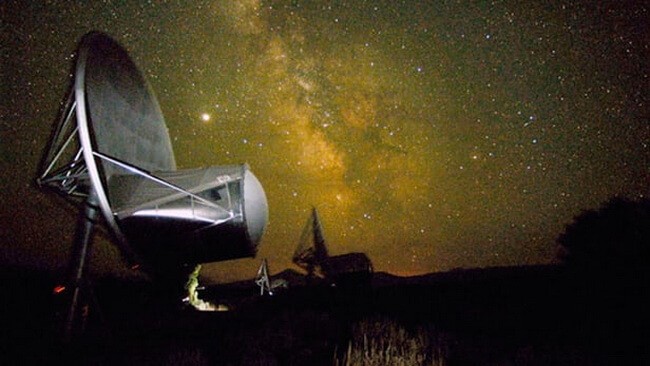- Get link
- X
- Other Apps

A powerful radio signal caught by astronomers and taken as a possible message transmission from an extraterrestrial civilization, in fact, is not. Russian scientists confirm that the signal is of terrestrial origin. It turned out that the received radio signal from the G-type star, located 94.4 light years in the constellation Hercules, is a signal from a military satellite during the Cold War.
According to the SETI Institute, Russian astronomers were the first to record this signal using the powerful RATAN-600 radio telescope. However, the news of this did not come under wide publicity until the discovery was discussed at a special timed event, where among the other guests was Claudio McConne, head of the International Academy of Astronautics at the permanent SETI committee.
The signal, allegedly received from the star HD 164595, immediately seemed very unusual to scientists. Its frequency was 1 GHz, which is billions of times higher than the frequency ranges that are commonly used in SETI to search for extraterrestrial civilizations. The radiation flux density of the received signal was 0.75 Yang (the unit is named after Karl Jansky, an American radio engineer and the founder of radio astronomy). One Jansky is equal to 10−26 W / (m2 • Hz). For comparison: the radiation density of a mobile phone at a distance of 1 kilometer is 110 Yang. Therefore, to overcome the 94 light years, the signal must have a much greater density than that which was recorded by scientists. If we assume that the signal was transmitted in all directions at once, then its density should have been 1020 W, which is approximately 100 times the flux density of all the sunlight reaching the Earth. If the signal was directed precisely in our direction, then its density should have been “only” one trillion watts.
In other words, if this signal was actually sent by an extraterrestrial civilization, then only super-civilization could send it, which is several orders of magnitude more developed than we. Unfortunately, repeated searches for a signal from the star HD 164595, held from 28 to 30 August with the help of the Allen Antenna Grill (ATA), did not give positive results.
Meanwhile, in an article by the TASS news agency, the director of the Institute of Applied Astronomy of the Russian Academy of Sciences of the Russian Academy of Sciences, Alexander Ipatov, reports that in fact this signal is of earthly origin. Its source is an old Soviet satellite, which either transmitted or reflected the signal to astronomers. Later this information was confirmed by scientists from the Special Astrophysical Observatory of the Russian Academy of Sciences, who commented on this event as follows:
"We can say with confidence that, unfortunately, none of the required desired signals has yet been detected."
The article is based on materials .
- Get link
- X
- Other Apps
Comments
Post a Comment